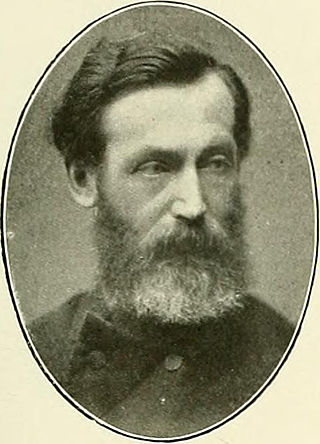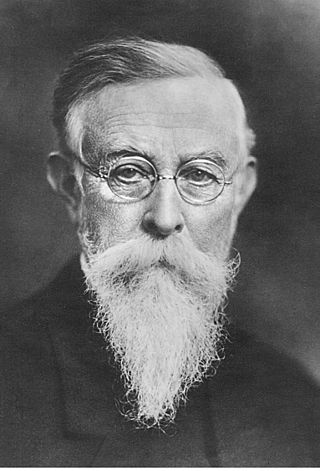Related Research Articles
Günther Ritter Beck von Mannagetta und Lerchenau[a] was an Austrian botanist.

Alexander Carl Heinrich Braun was a German botanist from Regensburg, Bavaria. His research centered on the morphology of plants.
Otto Wilhelm Thomé (1840–1925) was a German botanist and botanical artist from Cologne, best known for his compendium of botanical illustrations Flora von Deutschland, Österreich und der Schweiz in Wort und Bild für Schule und Haus, the first of 4 volumes with a total of 572 botanical illustrations, published in 1885 in Gera, Germany. Another 8 volumes were added to the set by Walter Migula with the republication in 1903. From 1897 to 1899, he was the Headmaster of the Business School Cologne.

Monera is historically a biological kingdom that is made up of prokaryotes. As such, it is composed of single-celled organisms that lack a nucleus. It has been superseded by the Four-kingdom system.

Ferdinand Christian Gustav Arnold was a German lichenologist and taxonomist born in Ansbach, Bavaria. Even as a high school student he showed an active interest in botany: "Ich und August Gattinger ... durchstreiften von November 1846 bis zum Spätherbst 1847, Pflanzen sammelnd, die Landschaft von München nach allen Richtungen.".
Heinrich Christian Funck was a German pharmacist and bryologist. He was a co-founder of the Regensburg Botanical Society.

Sphacelariales is an order of brown algae.
Heinrich Simon Ludwig Friedrich Felix Rehm was a German mycologist and lichenologist. He studied at the Universities of Erlangen, Munich and Heidelberg, earning his medical doctorate in 1852. During his career, he was a practicing physician in Dietenhofen, Sugenheim, and Windsheim. In 1875, he became regional medical examiner in Lohr am Main.
Gustav Hegi was a Swiss botanist. His name is particularly associated with editing the multi-volume work Illustrierte Flora von Mittel-Europa, which is one of the most comprehensive floras in the World. It contains extensive morphological, ecological and phytogeographical of all plant species occurring in Central Europe.

Scapaniaceae is a family of liverworts in order Jungermanniales. The family has been extended to include the former family Lophoziaceae.

Gottlob Ludwig Rabenhorst was a German botanist and mycologist.

Ernst Stizenberger was a German physician and lichenologist.

Hermann Merxmüller was a German botanist and taxonomist.
Victor Félix Schiffner was an Austrian bryologist specializing in the study of hepatics.
Wilhelm Mönkemeyer was a German bryologist.
Karl Gustav Limpricht was a German schoolteacher and bryologist. His son, Hans Wolfgang Limpricht, was a botanical collector in China.

Andreas Allescher was a German schoolteacher and mycologist.

Carl or Karl von Tubeuf FLS HFRSE was a German forestry scientist, mycologist and plant pathologist. He introduced both the term biological control and the use of a biological control to manage a plant disease. He published one of the first books on plant diseases In addition to foundational work in plant pathology, he published broadly on other topics including forest botany, dendrology, mycology, and zoology. He discovered new species of gall mites of conifers.
Johannes Hillmann (1881–1943) was a German teacher, botanist, and lichenologist.

Exsiccata is a work with "published, uniform, numbered set[s] of preserved specimens distributed with printed labels". Typically, exsiccatae refer to numbered collections of dried herbarium specimens or preserved biological samples published in several duplicate sets with a common theme or title, such as Lichenes Helvetici. Exsiccatae are regarded as scientific contributions of the editor(s) with characteristics from the library world and features from the herbarium world. Exsiccatae works represent a special method of scholarly communication. The text in the printed matters/published booklets is basically a list of labels (schedae) with information on each single numbered exsiccatal unit. Extensions of the concept occur.
References
- ↑ "Flora von Deutschland, Österreich und der Schweiz". Archived from the original on 2016-10-12.
- ↑ Triebel, D. & Scholz, P. 2001–2024 IndExs – Index of Exsiccatae. – Botanische Staatssammlung München: http://indexs.botanischestaatssammlung.de. – München, Germany.
- ↑ HathiTrust Digital Library Kryptogamen-Flora von Deutschland, etc
- ↑ WorldCat Identities (publications)
- ↑ International Plant Names Index. Mig.